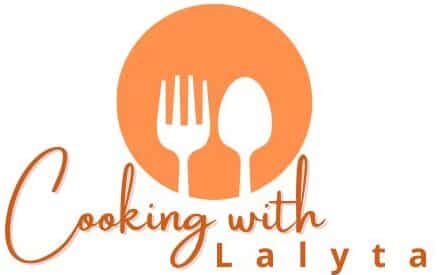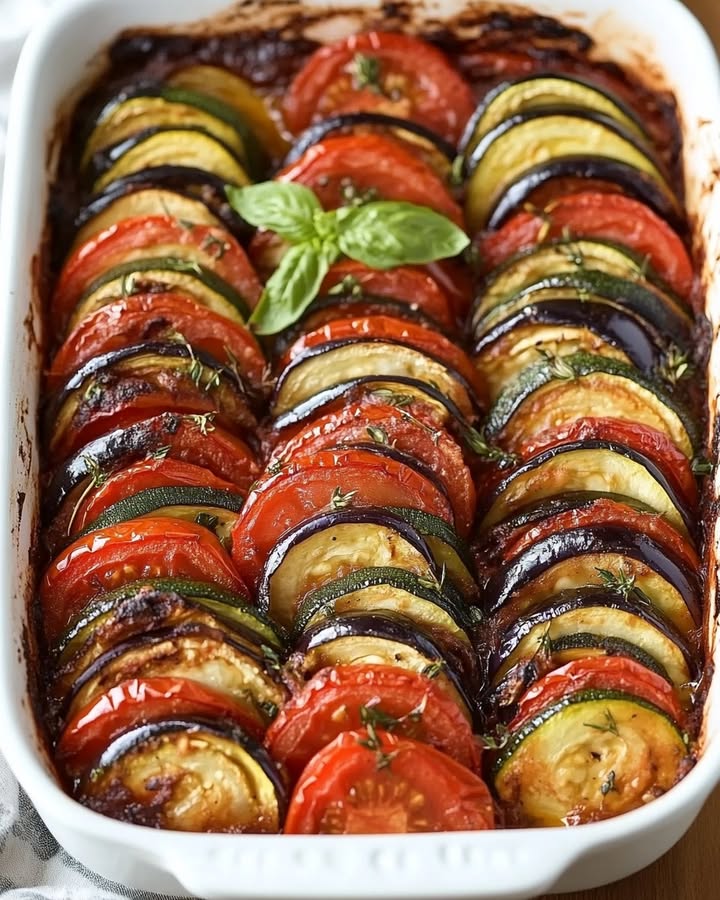Classic Baked Ratatouille with Tomatoes and Zucchini: A Rustic French Delight
Classic Baked Ratatouille with Tomatoes and Zucchini brings the flavors of Provence to your table with minimal effort. This rustic French dish layers fresh summer vegetables in a harmonious blend that transforms simple ingredients into something extraordinary. When you bake ratatouille, the tomatoes break down into a rich sauce while the zucchini and eggplant absorb all the herbal goodness.
Imagine tender slices of zucchini and eggplant mingling with sweet tomatoes and aromatic herbs. The oven works its magic, caramelizing the edges of the vegetables while keeping their centers perfectly tender. This version of baked ratatouille delivers both visual appeal and deep, satisfying flavors that improve with time, making it ideal for meal prep or entertaining.
Quick Recipe Highlights
- Flavor Profile: Earthy eggplant and sweet tomatoes balance with fresh herbs and garlic for a Mediterranean taste sensation
- Texture: Silky soft vegetables with just enough bite create a satisfying mouthfeel in every forkful
- Aroma: Fragrant basil, thyme, and garlic will fill your kitchen with irresistible scents as the ratatouille bakes
- Visual Appeal: The colorful spiral of red tomatoes, green zucchini, and purple eggplant makes a stunning presentation
- Skill Level Needed: Beginner cooks can master this recipe with its simple slicing and layering technique
- Special Equipment: A mandoline slicer helps achieve uniform vegetable slices but isn’t strictly necessary
Recipe Overview
- Difficulty Level: This baked ratatouille recipe falls into the easy category because it requires no advanced techniques. You simply slice, layer, and bake the vegetables with minimal hands-on time.
- Category: Perfect as a vegetarian main, hearty side dish, or plant-based meal option that satisfies various dietary preferences.
- Cuisine: Hailing from Provence in southern France, ratatouille showcases the region’s abundant summer produce and simple cooking philosophy.
- Cost: Using seasonal vegetables makes this an economical dish that delivers maximum flavor for minimal investment.
- Season: Summer and early fall offer the best produce for authentic ratatouille when tomatoes and zucchini peak in flavor.
- Occasion: Serve this versatile dish at casual weeknight dinners, elegant dinner parties, or as part of a buffet spread.
Why You’ll Love This Recipe
The Classic Baked Ratatouille with Tomatoes and Zucchini delivers layers of flavor in every bite. First, the natural sweetness of ripe tomatoes forms a rich base that complements the earthy eggplant and mild zucchini. Next, the garlic and herbs infuse the vegetables with aromatic depth that develops during baking. Furthermore, the simple preparation lets the quality of fresh ingredients shine through without complicated techniques.
Convenience makes this baked ratatouille recipe stand out for busy cooks. After the initial vegetable slicing, the oven does most of the work. Meanwhile, you can prepare other components of your meal or simply relax. Additionally, the dish tastes even better the next day, making it perfect for meal prep or leftovers that maintain their texture and flavor.
Nutritionally, this vegetable-packed dish delivers vitamins, minerals, and fiber with relatively few calories. The olive oil provides heart-healthy fats while the variety of vegetables ensures a broad spectrum of nutrients. Importantly, the slow baking process helps preserve more nutrients than high-heat cooking methods while developing deep flavors.
For entertaining, the visual appeal of Classic Baked Ratatouille with Tomatoes and Zucchini makes it a showstopper. Guests always appreciate the beautiful spiral pattern of colorful vegetables. Moreover, the dish accommodates various dietary preferences since it’s naturally vegetarian, vegan, and gluten-free without any modifications.
Cost-effectiveness comes from using humble, seasonal vegetables that transform into something special. When tomatoes and zucchini overflow in gardens and farmers markets, this recipe makes excellent use of abundant produce. Consequently, you can create an impressive dish without expensive ingredients or complicated preparations.
Historical Background and Cultural Significance
Ratatouille originated in Provence, France, where cooks developed this peasant dish to make the most of summer’s vegetable bounty. Originally, the recipe involved simple stewing of whatever vegetables were available. Over time, the dish gained popularity throughout France and eventually internationally as a symbol of Provençal cuisine.
The cultural significance of ratatouille extends beyond its ingredients. It represents the French approach to cooking that emphasizes quality seasonal produce prepared with respect. Interestingly, the dish gained global recognition after the 2007 Pixar film featuring a rat who dreams of becoming a chef in Paris.
Traditional ratatouille preparation methods vary by region and family tradition. Some versions call for cooking all vegetables together in a pot, while others layer and bake them as in this Classic Baked Ratatouille with Tomatoes and Zucchini. The baked method, sometimes called “confit byaldi,” creates a more elegant presentation while maintaining authentic flavors.
Regional variations reflect local produce availability and preferences. For instance, some areas include bell peppers or mushrooms, while others stick strictly to eggplant, zucchini, tomatoes, and onions. Regardless of variations, the essence of ratatouille remains a celebration of fresh vegetables prepared simply to highlight their natural qualities.
Ingredient Deep Dive
Eggplant forms the backbone of Classic Baked Ratatouille with Tomatoes and Zucchini, providing meaty texture and earthy flavor. This versatile nightshade vegetable originated in Asia but became integral to Mediterranean cooking centuries ago. When selecting eggplants, choose firm, glossy specimens with no soft spots. Smaller eggplants tend to have fewer seeds and milder flavor. Store them at cool room temperature for a day or two, or refrigerate for up to five days in a perforated bag.
Zucchini brings mild sweetness and bright color to the ratatouille. This summer squash originated in Central America but became a staple in Mediterranean cuisine. Look for small to medium zucchini with vibrant green skin and no blemishes. The skin should feel slightly rough but not wrinkled. Store zucchini in the refrigerator crisper drawer where it will keep for about a week. For best results in baked ratatouille, slice zucchini about 1/4-inch thick to maintain structure during cooking.
Tomatoes provide the essential saucy base and sweet acidity that balances the other vegetables. Choose ripe but firm tomatoes with deep color and fragrant aroma. Heirloom varieties offer excellent flavor, but any good-quality tomato will work. If fresh tomatoes aren’t at their peak, you can substitute high-quality canned San Marzano tomatoes. Never refrigerate tomatoes as cold temperatures destroy their texture and flavor. Instead, store them stem-side down at room temperature away from direct sunlight.
Common Mistakes to Avoid
- Skipping the salting step for eggplant can result in bitter flavors and excess moisture in your baked ratatouille. Always salt eggplant slices and let them drain for at least 15 minutes before patting dry.
- Cutting vegetables unevenly leads to inconsistent cooking. Use a mandoline or sharp knife to create uniform slices about 1/4-inch thick for even baking.
- Overcrowding the baking dish prevents proper caramelization and steaming. Arrange vegetables in a single layer with slight overlap for the classic spiral pattern.
- Using out-of-season vegetables compromises flavor. Wait until summer when tomatoes, zucchini, and eggplant reach their peak sweetness and texture.
- Skipping the fresh herb garnish misses an opportunity to brighten flavors. Add chopped fresh basil or parsley just before serving for maximum impact.
- Underseasoning leaves the dish tasting flat. Remember to season each layer lightly as you assemble the ratatouille.
- Overbaking turns vegetables mushy. Check for doneness at 40 minutes – vegetables should be tender but still hold their shape.
- Serving immediately after baking doesn’t allow flavors to meld. Let the baked ratatouille rest 10-15 minutes before serving for best texture and taste.
Essential Techniques
Proper vegetable preparation makes all the difference in Classic Baked Ratatouille with Tomatoes and Zucchini. First, salting the eggplant draws out excess moisture and any potential bitterness. After salting, rinse and pat the slices dry to ensure proper texture in the final dish. This step prevents watery ratatouille and improves the eggplant’s ability to absorb flavors during baking.
Uniform slicing ensures even cooking throughout the baking process. Whether using a mandoline or sharp knife, aim for consistent 1/4-inch thick slices. This thickness allows vegetables to soften properly without disintegrating. Additionally, uniform slices create the beautiful spiral presentation that makes baked ratatouille so visually appealing.
Layering technique affects both presentation and flavor distribution in the final dish. Start with a thin layer of tomato sauce on the bottom to prevent sticking. Then arrange vegetable slices in concentric circles, alternating types for color contrast. Slightly overlap each slice to create the signature spiral pattern that defines this preparation method.
Pro Tips for Perfect Classic Baked Ratatouille
- Choose vegetables with similar diameters for uniform slices that create an attractive spiral pattern in your baking dish.
- Let the assembled ratatouille rest at room temperature for 15 minutes before baking to allow flavors to begin mingling.
- Cover with foil for the first 30 minutes of baking to steam vegetables, then uncover to caramelize the edges.
- Resist the urge to stir during baking – the layered presentation is part of ratatouille’s charm.
- Make extra tomato sauce to serve on the side for those who prefer saucier portions.
- Garnish with fresh herbs just before serving to preserve their bright color and flavor.
- Use leftover ratatouille in omelets, pasta sauces, or as a bruschetta topping for creative next-day meals.
Variations and Adaptations
Regional variations of Classic Baked Ratatouille with Tomatoes and Zucchini reflect local tastes and ingredient availability. In Nice, the traditional version includes bell peppers and sometimes mushrooms. Provençal cooks might add a splash of local rosé wine to the tomato base. For a Spanish twist, incorporate smoked paprika and chorizo slices between the vegetable layers.
Seasonal adaptations allow enjoyment of ratatouille year-round. In winter, use high-quality canned tomatoes and add roasted red peppers for brightness. Spring versions might include early zucchini and greenhouse tomatoes with extra herbs. Autumn ratatouille could incorporate roasted squash or sweet potatoes for heartier texture.
Dietary modifications make this dish accessible to various eating preferences. For vegan ratatouille, ensure all ingredients meet plant-based standards. Keto adaptations might reduce tomato quantity and increase olive oil. Gluten-free needs no adjustments as the recipe contains no grains. Low-FODMAP versions substitute garlic-infused oil for fresh garlic.
Serving and Presentation Guide
Plating techniques highlight the beautiful spiral pattern of Classic Baked Ratatouille with Tomatoes and Zucchini. Serve individual portions using a wide spatula to lift complete sections from the baking dish. Alternatively, present the entire dish at the table before portioning to showcase the colorful vegetable arrangement.
Garnishing ideas include fresh basil leaves, thyme sprigs, or a drizzle of high-quality olive oil. For texture contrast, sprinkle toasted pine nuts or breadcrumbs over the top. A dollop of herbed goat cheese or vegan cashew cream adds richness when serving.
Traditional accompaniments include crusty bread to soak up the flavorful juices. For complete meals, pair with grilled fish, roasted chicken, or lentil stew. Simple green salads with vinaigrette provide refreshing contrast to the rich vegetable flavors.
Wine and Beverage Pairing
Wine pairings for Classic Baked Ratatouille with Tomatoes and Zucchini should complement the dish’s Mediterranean flavors. A dry rosé from Provence mirrors the dish’s origins with bright acidity and berry notes. Light-bodied reds like Grenache or Pinot Noir stand up to the vegetables without overwhelming them.
Non-alcoholic alternatives include sparkling water with lemon or herb-infused iced teas. For something special, try a virgin spritz with elderflower cordial and soda water. These light, refreshing drinks cleanse the palate between bites of rich ratatouille.
Storage and Shelf Life
Storage methods preserve the quality of leftover Classic Baked Ratatouille with Tomatoes and Zucchini. Cool completely before transferring to an airtight container. Refrigerate for up to five days, with flavors improving over the first two days. For longer storage, freeze portions in freezer-safe containers for up to three months.
Reheating instructions vary by method. Gently warm refrigerated ratatouille in a covered skillet over low heat with a splash of water. Microwave individual portions at reduced power to prevent overcooking. Frozen ratatouille should thaw overnight in the refrigerator before reheating.
Make Ahead Strategies
Prep timeline for Classic Baked Ratatouille with Tomatoes and Zucchini allows convenient advance preparation. Slice vegetables up to a day ahead and store them separately in airtight containers in the refrigerator. Prepare the tomato sauce base up to three days in advance for deeper flavor development.
Storage between steps maintains ingredient quality. Keep sliced eggplant wrapped in damp paper towels to prevent browning. Store zucchini and tomato slices between layers of parchment paper to preserve texture. Bring all components to room temperature before assembling and baking.
Scaling Instructions
Halving the recipe works well for smaller households. Use a 9-inch pie dish or similar shallow baking vessel. Reduce baking time by 5-10 minutes since the smaller quantity will cook slightly faster. All other ingredient proportions and techniques remain the same.
Doubling or tripling requires multiple baking dishes rather than one very large one. This ensures proper cooking and presentation. Rotate dishes halfway through baking for even results. Consider increasing herb quantities slightly more than proportionally to maintain flavor balance.
Nutritional Deep Dive
Macro breakdown of Classic Baked Ratatouille with Tomatoes and Zucchini shows it’s naturally low in calories and carbohydrates. A serving provides about 120 calories, with 7g of healthy fats from olive oil, 3g of protein, and 12g of carbohydrates including 4g of fiber. This makes it suitable for various dietary approaches.
Micronutrient analysis reveals high levels of vitamins A and C from the colorful vegetables. Eggplant contributes potassium and antioxidants, while tomatoes provide lycopene. Zucchini offers manganese and additional vitamin C. Together, these nutrients support immune function and overall health.
Dietary Adaptations
Gluten-free needs no modifications as Classic Baked Ratatouille with Tomatoes and Zucchini contains no gluten-containing ingredients. For strict gluten-free diets, ensure all packaged ingredients like canned tomatoes carry gluten-free certification.
Vegan versions require only verification that the olive oil and tomato products meet plant-based standards. The recipe contains no animal products by default, making it naturally suitable for vegan diets without substitutions.
Troubleshooting Guide
Texture issues often stem from incorrect vegetable preparation or baking times. If vegetables turn out too firm, they may have been cut too thick or baked insufficiently. Conversely, mushy vegetables result from overbaking or failing to pat eggplant dry after salting.
Flavor balance problems can usually be corrected after baking. If the ratatouille tastes bland, stir in additional salt and fresh herbs before serving. For excessive acidity, a pinch of sugar or drizzle of olive oil can help mellow the flavors.
Frequently Asked Questions
Can I make ratatouille without eggplant? Yes, though eggplant contributes significantly to the dish’s character. Substitute additional zucchini or yellow squash if needed, but expect a different texture and flavor profile.
How do I prevent watery ratatouille? Properly salting and draining eggplant, using ripe but firm tomatoes, and avoiding overbaking all help maintain ideal texture. If excess liquid remains, carefully pour it off before serving.
Can I use dried herbs instead of fresh? While fresh herbs provide superior flavor, you can substitute 1/3 the amount of dried herbs. Add them to the tomato sauce rather than sprinkling on top for better distribution.
What’s the best baking dish for ratatouille? Choose a shallow, round ceramic or glass dish that allows for attractive spiral arrangement. A 10-12 inch diameter works well for the standard recipe quantity.
How do I know when ratatouille is done baking? Vegetables should be tender when pierced with a fork but still hold their shape. The tomato sauce should bubble gently at the edges, and the top vegetables may show slight caramelization.
Additional Resources
Related recipes that complement Classic Baked Ratatouille with Tomatoes and Zucchini include crusty no-knead bread and simple green salads. For similar vegetable-focused dishes, explore recipes for tian Provençal or Greek briam. These Mediterranean vegetable bakes share ratatouille’s philosophy of celebrating seasonal produce.
Technique guides for perfect vegetable slicing and layering can elevate your ratatouille presentation. Mastering basic knife skills or learning to use a mandoline safely ensures uniform slices. Understanding vegetable cooking times helps create perfectly tender results every time.
PrintClassic Baked Ratatouille with Tomatoes and Zucchini
Description
A vibrant and hearty vegetable dish featuring layers of tomatoes, zucchini, and eggplant, baked to perfection with aromatic herbs.
Ingredients
For the Crust:
- 2 medium zucchinis, thinly sliced
- 1 large eggplant, thinly sliced
- 4 medium tomatoes, thinly sliced
- 1 onion, thinly sliced
- 3 cloves garlic, minced
- 1/4 cup olive oil
- 1 tsp dried thyme
- 1 tsp dried rosemary
- Salt and pepper to taste
- 1/4 cup grated Parmesan cheese (optional)
Instructions
1. Prepare the Crust:
- Preheat oven to 375°F (190°C). Lightly grease a baking dish with olive oil.
- Arrange the sliced zucchini, eggplant, tomatoes, and onion in alternating layers in the prepared baking dish.
- In a small bowl, mix the minced garlic, olive oil, thyme, rosemary, salt, and pepper. Drizzle this mixture evenly over the layered vegetables.
- Cover the dish with aluminum foil and bake for 25 minutes. Remove the foil, sprinkle with Parmesan cheese if using, and bake uncovered for an additional 5-10 minutes until the vegetables are tender and the top is lightly golden.
- Let the ratatouille rest for 5 minutes before serving. Enjoy warm or at room temperature.
Notes
You can customize the seasonings to taste.









